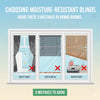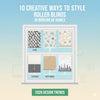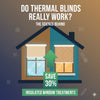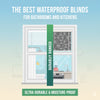A Complete Buyer's Guide to Energy-Efficient Blinds (with Expert Insights)
- by Mariam Labadze
Quick Answer
Energy-efficient blinds reduce heating and cooling costs by 15-25% through insulating windows—your home's weakest thermal points. The most effective options include cellular honeycomb designs with R-values up to 5.0, thermal-backed roller blinds reflecting solar heat, and wooden venetians providing natural insulation. Key features include proper fit minimizing air gaps, light-colored exteriors reflecting summer sun, and multiple layers trapping insulating air. Strategic usage matters tremendously—closing blinds at dusk during winter retains heat, whilst daytime closure during summer blocks solar gain. Quality energy-efficient blinds cost £60-£150 per window but deliver payback within 2-4 years through reduced utility bills, making them sound investments for comfort and cost savings.
Understanding Window Heat Loss
Windows account for 25-30% of residential heating and cooling costs despite representing only 10-15% of exterior surfaces. This disproportionate energy loss occurs because glass conducts heat far more readily than insulated walls—even quality double-glazing provides minimal thermal resistance compared to properly insulated wall sections.
Three heat transfer mechanisms affect windows: conduction through glass and frames, convection from air movement near cold surfaces, and radiation from infrared energy passing through glass. Energy-efficient blinds address all three simultaneously, creating measurable improvements in thermal performance.
The air gap between blinds and glass creates dead air space—stationary air acts as excellent insulation by preventing convective heat transfer. This principle explains why cellular designs with trapped air pockets perform exceptionally well, essentially creating multiple insulating barriers between interior spaces and cold exterior glass.
Cellular Blinds: The Insulation Champions
Honeycomb or cellular blinds represent the gold standard for window insulation through distinctive structures featuring hexagonal cells trapping air in pockets. Single-cell designs provide good insulation suitable for moderate climates, whilst double-cell constructions essentially double insulating capacity through two trapped air layers.
Quality cellular blinds achieve R-values between 2.0-5.0—adding this insulation to windows' baseline R-1 to R-3 significantly improves overall thermal performance. This enhancement proves particularly valuable for older properties with single-glazing or homes in extreme climates where heating and cooling demands create substantial energy expenses.
Cell size affects performance moderately, with larger 19mm cells providing slightly better insulation than smaller 9-13mm options due to increased air volume. However, the difference proves modest enough that aesthetic preferences regarding visible cell size represent reasonable selection criteria alongside pure thermal performance.
Light-filtering cellular blinds provide insulation whilst admitting natural daylight, reducing artificial lighting needs that contribute to cooling loads. Blackout versions offer maximum thermal performance alongside complete darkness valuable in bedrooms where both energy efficiency and sleep quality matter.
Top-down configurations allow lowering blinds from tops whilst keeping bottoms raised, admitting natural light whilst maintaining insulation and privacy—optimal arrangements for many daytime situations maximizing both comfort and efficiency.
Thermal Roller Blinds: Practical Efficiency
Thermal roller blinds combine standard rollers' simplicity and clean aesthetics with specialized backing materials engineered for energy efficiency. Foam, aluminum, or synthetic layers bonded to decorative fabrics reflect radiant heat whilst creating modest insulating air gaps between fabric and glass.
These practical solutions deliver R-values around 1.0-2.0—not matching cellular performance but significantly better than standard fabric alone. The slim profile suits any window size or configuration without the bulk that cellular designs might present in compact recesses or shallow mounting depths.
Reflective thermal blinds work particularly effectively for solar heat rejection during summer months. Light-colored or metallic-backed fabrics bounce sunlight before it converts to heat inside homes, noticeably reducing cooling requirements in south and west-facing rooms receiving intense afternoon sun.
Blackout thermal rollers combine light blocking with insulation, making them ideal for bedrooms where both functions prove valuable. The dense materials providing darkness inherently improve thermal performance compared to lightweight fabrics, delivering dual benefits through single solutions.
Installation positioning affects thermal performance. Face-mounting outside recesses with fabric extending beyond frames provides better edge sealing, reducing air leakage that compromises insulation regardless of material quality. This mounting approach typically delivers superior energy savings compared to recess installations.
Wooden Venetian Blinds: Natural Insulators
Wood's cellular structure inherently resists heat transfer better than aluminum or vinyl, making wooden venetians surprisingly effective for energy management despite not being specifically marketed as thermal solutions. Real wood slats create modest insulation even when open, with thermal advantages increasing substantially when closed tightly.
Substantial 25-50mm slat thickness creates more insulating mass than thin alternatives, slowing temperature transfer through conduction. Combined with air gaps between closed slats adding convective resistance, wooden venetians deliver combined thermal benefits impossible in thinner materials.
Slat angle adjustment optimizes passive solar heating during winter. Position slats admitting low-angle winter sunlight whilst maintaining privacy, allowing natural warming reducing heating requirements. This control proves impossible with fixed treatments, giving venetians unique flexibility for seasonal energy optimization.
Summer strategies involve closing slats against intense sun, blocking direct solar gain whilst maintaining some natural ventilation through gaps. This balanced approach reduces cooling loads whilst avoiding the stuffiness that completely closed treatments might create during warm weather.
Faux wood alternatives provide similar thermal benefits with enhanced moisture resistance for bathrooms and kitchens. Composite materials may actually exceed real wood's insulating properties through engineered cellular structures optimized for thermal performance beyond what natural wood achieves.
Proper Installation for Maximum Efficiency
Even highest-performing thermal blinds deliver disappointing results when poorly fitted. Air gaps around edges allow convection currents undermining insulation, making proper installation crucial for achieving advertised energy savings and justifying premium costs over basic alternatives.
Recess mounting within window frames creates integrated appearances but may leave gaps between blind edges and frame sides. These gaps permit air circulation reducing thermal effectiveness significantly. Measure recess dimensions carefully, ordering blinds fitting snugly without binding during operation.
Face-mounting to walls or ceilings above windows allows blinds extending beyond frames on all sides, minimizing edge gaps substantially. This approach typically delivers superior thermal performance compared to recess mounting, making it preferable for energy-focused installations despite slightly more prominent appearances.
Side channels for roller and cellular blinds create sealed edges eliminating air gaps entirely. Track systems guide blind edges within channels mounted to frame sides, preventing convective air movement that compromises insulation. The modest additional cost proves worthwhile for maximum energy savings in particularly challenging windows.
Strategic Usage for Maximum Savings
Owning energy-efficient blinds doesn't guarantee savings—strategic use optimizes thermal performance through daily and seasonal adjustments responding to weather conditions and solar positioning that change continuously.
Winter strategy involves closing blinds at dusk before temperatures drop, trapping interior warmth accumulated during the day. Open south-facing blinds during sunny days allowing passive solar heating, then close before sunset preventing accumulated heat escaping through cold nighttime glass.
Summer strategy requires closing blinds on south and west-facing windows during intense afternoon sun, preventing solar heat gain that increases cooling loads dramatically. East-facing windows benefit from morning closure preventing early heat buildup, whilst evening opening allows natural cooling when outdoor temperatures drop.
Shoulder season optimization during spring and autumn requires responsive approaches balancing heating and cooling needs that fluctuate daily. Use blinds actively—closing against unexpectedly warm sunshine or cold winds, opening to harness beneficial conditions maximizing comfort whilst minimizing HVAC runtime.
Nighttime closure during cold months significantly reduces overnight heat loss regardless of daytime strategy. Nighttime represents peak heat loss periods when temperature differences between interior and exterior maximize, making evening closure particularly impactful for energy savings.
Calculating Your Potential Savings
A typical UK home with 12 windows spending £1,800 annually on heating and cooling might save 15-25% through comprehensive thermal blind installation—representing £270-£450 annual savings or £22-£37 monthly. These meaningful reductions in household budgets support environmental goals whilst delivering financial benefits.
Investment costs vary by treatment type and window sizes. Budget thermal rollers might total £600 covering 12 standard windows, whilst premium cellular designs could reach £1,800 for equivalent coverage. Payback periods range from 1.5-6 years depending on treatment choices and home-specific savings rates.
The most aggressive savings occur in poorly insulated homes where windows currently contribute disproportionately to energy losses. Modern well-insulated properties see more modest percentages but still meaningful absolute savings justifying reasonable investments in quality treatments.
South and west-facing windows in sunny locations deliver highest summer cooling savings through solar heat rejection. North-facing windows in cold climates provide greatest winter savings through heat retention. Prioritizing treatment investments toward highest-impact orientations maximizes returns when budgets prevent simultaneous whole-home coverage.
At 1 Click Blinds, we help UK homeowners select energy-efficient solutions matching their specific needs, climates, and budgets. Our cellular designs, thermal rollers, and wooden venetians deliver measurable energy savings alongside quality and aesthetics that enhance homes beautifully whilst reducing utility bills for years to come.







